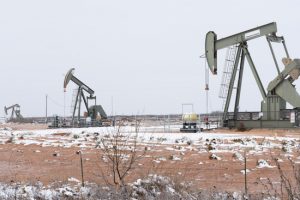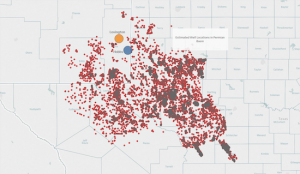LOVINGTON—The 61-mile drive on US 82 from Artesia to this southeast New Mexico town crosses the heart of the Permian Basin oil field’s extension into the state. Pump rigs bob like great iron dinosaurs come to life, and the smell of petroleum fills the air. Flare pipes burn off natural gas and methane like fire-breathing dragons.
It’s the scent of economic opportunity for some, the stench of impending danger to
others. Industry experts and environmentalists agree on one thing: the September 2018 sale of nearly $1 billion in federal leases has set off one of the greatest oil booms in American history and has overwhelmed everything from the region’s highway to its housing supply.

Lea County expects to double in population, and law enforcement and fire officials are
concerned that rapid growth will strain their meager resources. Lovington city manager James Williams is working to entice housing developers and making plans to repair the town’s aging infrastructure through increased gross receipts taxes and other revenue.
“Of course, that does allow the city to do more,” he said. “You know, fix roads, repair our aging water and sewer lines that are leaking.”
Local businesses are increasingly pressed to keep up with demand for everything from
groceries to pickup parts. Everybody’s hiring, including city hall, which has lost several employees to good-paying jobs in the fields. An oil pumper averages more than $46,000 a year, according to salary.com, and some workers make twice that. But even those numbers pale in
comparison to the $90,000 to $120,000 salaries possible for experienced drillers and commercial truckers.
The rush also places unprecedented stress on the state’s ability to oversee the industry and
enforce regulations. A bonding capacity increase was considered a hard-fought victory with
Republican Governor Susana Martinez in office. New Mexico House Speaker Brian Egolf said
he intends to build on that success, in part by balancing the interests of the industry, the
environmentalists, and the state.
It is indisputable that there is not enough funding for the New Mexico Environment
Department, which processes oil and gas drilling permits. The hiring of additional staff is
overdue, and essential to accommodating the industry while ensuring the protection of the
environment.
More staffing can reduce the amount of wait time during the drilling permit issuing
process, which Egolf calls a “high priority” in the upcoming session of the Legislature. It also
means having more trained state personnel to oversee the double casing and cement work
essential to protecting the aquifer. With treated water under high pressure, even minor flaws in
the breakdown of wells, ruptures in pipes, and damage to the environment.
“More inspectors means the quality of the cement jobs will go up,” Egolf said. “It’s a
win-win for everybody. It’s good for the industry to have [the process] done more quickly, and
it’s good for the environment because we’ll have more inspectors on the job. It’s something we’ll
put on the front burner for sure in the next session.” With larger petroleum companies interested in New Mexico oil, Egolf said, bigger may actually be better for the state — historically, smaller
companies have generated many of the environmental problems.
“More inspectors … will make me and others much more comfortable that production
can be done without serious risk to groundwater.”
Drinking water at risk?
Underlying everything, literally and metaphorically, is Lovington’s municipal water
supply, located approximately five miles south of town. More oil drilling activity increases the
risk of contamination to the Ogallala Aquifer-fed well system. One third of the oil-industry wells
are now being sunk to dispose of endless millions of gallons of “produced water,” or water that
returns to the surface after hydraulic fracturing. This process not only adds to the cost of
extracting oil and gas but also endangers the groundwater upon which residents rely.
That risk is something former Lovington city manager Pat Wise knows plenty about.
Back in 2003, unreported oil and effluent spills and discarded drill-rig equipment turned the
town’s municipal water-well field — the source of its drinking water — into a polluted junkyard.
Joined by other city officials, Wise demanded action from the OCD.

“I forced them to do that, to clean up their mess,” Wise, 69, recalled during an interview
at his longtime family home on 5th Street. “That didn’t curry me much favor with the oil and gas
companies, but I didn’t really care. My first job was to protect that water table.” Today Wise
heartily endorses Lovington’s water quality.
Not everyone does. James Compton, for one, was convinced that something in
Lovington’s water caused his glioblastoma — an aggressive kind of brain tumor. Not just his, but
others’ as well.
The son of an oil field worker, 34-year-old Compton was raised in Lovington and had
fond memories of the town he knew as a boy. He understood that the prosperity of the town
depended on the oil fields, even if the air held the odor of petroleum and the drinking water
sometimes smelled.
After high school, Compton attended college and worked a variety of jobs locally and as
far away as Denver. He started a cleaning service and a delivery company, worked on websites
and was employed for a while by a computer company.
He eventually returned to Lovington, where in 2017 his cancer was diagnosed. He
immediately suspected environmental factors, recalling the taste of the water and the smell of the
pool in which he swam daily for many years. Within weeks of his diagnosis, he began
“investigating my own murder,” as he called it.
Compton took to social media and attracted more than a thousand followers on Facebook
as his condition worsened. He collected several dozen names of other cancer patients – many of
whom could not be independently verified. With his friend Rachel Lehcar, Compton started the
Lea County Cancer Cluster page on Facebook and the leacountycancer.com website.
His efforts ultimately attracted the attention of Lovington city officials. Last summer,
Williams called for an independent test of the municipal water-well quality and contacted the
New Mexico Department of Health, which reported that the rates between Lea County and the
rest of the state showed no statistical difference between 2011 and 2015. “With glioblastoma diagnosis rates at 2.5 per 100,000 in Lea County and 2.4 per 100,000 statewide, both are below
the national average of 3 per 100,000,” the Department of Health concluded.
Charles Wiggins, director and principal investigator of the New Mexico Tumor Registry
at the University of New Mexico school of medicine, concurred. “We found that the rates of that
tumor were about the same, or very similar, to the rest of the state.”
Williams vows that “protection and preservation of our municipal water supply is our
number-one priority, along with conservation as well,” pointing out that his own family
consumes the water. Lovington’s water is tested monthly for quality, including a chemical
analysis that notes any increase in dangerous chemicals and byproducts — some of them
carcinogenic — associated with petroleum drilling.
“We recognize there is always a potential for it, but we do everything in our power to
mitigate and eliminate that risk,” said Williams, adding that Compton’s concerns “did not change any of our protective mechanisms we’ve got in place or any of our testing. It just provided us some information that does say that the rates here in Lovington and Lea County are not higher than anywhere else.”
Of course, that is no solace to those diagnosed with cancer. After Compton died on Oct.
21, Lehcar posted on Facebook that she would continue the fight, but “we just had to hit the
pause for a bit.”
An economic engine that requires oversight
It’s important to understand the scale of the oil and gas industry in southeast New
Mexico. Lea and adjacent Eddy counties have long been New Mexico’s leading oil producers, even before the boom that accompanied the rise of hydraulic fracking technology. The Permian
Basin, 250 miles wide and 350 miles long, takes up most of west Texas and extends into eastern
New Mexico. It’s been the source of more than 500,000 barrels of crude per day with
predictions of more than double that production in the coming months.

Environmentalists and some state officials say that New Mexico’s unique geology puts its
groundwater at greater risk than other states where fracking has been shown to contaminate
water supplies. In the Permian, the groundwater aquifer rests on a basin of limestone. Beneath
that is a salt bed. With oil shale resting from 3,000 to 15,000 feet beneath the surface, a single
drilling through limestone takes millions of gallons of freshwater. Despite improvements in the
process, public and private agencies acknowledge the risk of groundwater contamination is high
in all affected counties.
While controversy has long surrounded the hydraulic fracturing process, industry
proponents argue the process poses little serious risk to water sources if done properly. But the
EPA has disagreed, finding that thousands of wells throughout the West are vulnerable to
contamination.
At the state level, the OCD gathers well production data; permit[s] new wells; enforces
the division’s rules and the state’s oil and gas statutes; make[s] certain abandoned wells are
properly plugged; and ensure[s] the land is responsibly restored,” division director Heather Riley notes on the agency’s website. But with fewer than two dozen inspectors, enforcing its mandate may be impossible.
In 2012, Earthworks — an environmental nonprofit organization based in Washington,
D.C. — produced a study that found OCD had failed to “fulfill its duty to the law, and to the
public interest.” If there is enough money to drill throughout the region, Bruce Baizel, energy
program director for the organization, said, there should be enough funds to strengthen regulation and improve enforcement. He sees it as “make hay while the sun is shining moment for New Mexico. It’s got a lot of revenue and, yes, there are a lot of issues facing New Mexico:
education, health care, and jobs need to be addressed. With so much revenue, now it’s incumbent upon the state to take advantage of that revenue and ratchet enforcement so the environmental impacts of the oil and gas boom are minimized.”
CORRECTION: An earlier version of this story indicated misidentified the Oil Conservation
Division as part of the New Mexico Environment Department. It is part of the Energy, Minerals
and Natural Resources Department.